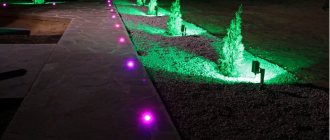Lighting a garden or personal plot is an important element not only of beauty, but also of safety. To be convinced of this, just one walk around the backyard or garden with a hand-held flashlight is enough. A well-thought-out and competent lighting system makes it easy to navigate the garden plot at night and move around it with a high level of safety. With the help of decorative lighting of flower beds, garden paths, steps and trees, you can create an individual atmosphere in your garden plot and extend the time of communication with nature.
There are two types of street lighting:
- utilitarian (functional);
- decorative
Let's look at specific examples of landscape design projects in which garden lighting is used, how you can not only protect yourself, your household and guests of a country or urban private household, but also give your garden plot an atmosphere of celebration, mystery or romanticism.
What is street lighting like?
In the manufacture of lighting fixtures intended for outdoor use, various materials are used:
- glass,
- plastic,
- forging,
- steel.
Depending on the geographical location, lighting devices can be made in different styles. When there is a specially developed design project, the street lighting can be made in the Baroque style, or high-tech, etc.
High-tech street lighting sources
It is worth understanding that external lighting is divided into main types:
- street lighting,
- roadway lighting,
- external, including decorative,
- pedestrian paths and sidewalks.
There is also a difference in the light sources themselves. They are:
- Fluorescent lamps. They are characterized by a long service life and high luminous efficiency. In addition, they are quite economical, operate silently and have small dimensions.
- Induction lamps. These are electrodeless lamps that operate thanks to a gas cylinder located together with an inductor. Light is produced by plasma.
- Xenon lamps. The light here comes from an electric arc located between two electrodes. Due to the internal content of such lamps, light radiation here can be of a different spectrum.
- Incandescent lamps. They have high power and good heat dissipation, but at the same time they are quite expensive. A separate type of such lamps is halogen, which have a longer service life. This is due to a special additive in the form of a buffer gas.
- Mercury lamps. The basis of the work is the formation of a gas discharge in mercury vapor. When lighting of streets and roads is necessary, general purpose lamps are used. They are economical, therefore, when there is a need to illuminate large areas, their use will be advisable.
- Solar powered lighting. This is a separate type of street lighting device, which is the most economical. The main feature is that there is no need for human participation in the operation of such devices, since there is no connection to the electrical network. They can be used both to illuminate private courtyards and to illuminate city streets. When it is light outside, these lights turn off automatically. And throughout the day they accumulate energy, which they release at night. They are used not only as lanterns, but also as decorative street lighting.
City street lighting concept
Urban lighting is not just about installing lights in poorly lit areas. This part of the work is usually included in the planning of neighborhoods and new streets, it is necessary to carry out wiring and select options that best suit the surrounding environment.
Features and rules of the organization
To ensure high-quality lighting, a number of important aspects must be taken into account. They may vary depending on external conditions and other features. But the main ones are always the same:
- It is necessary to think through the prospects for the development of the microdistrict and the emergence of new buildings. Plan at least 10 years in advance so that you don’t have to redo the lighting plan later.
- The quantity and features of already operating lighting equipment are taken into account. This can either be an addition to existing systems, either with or without modernization, or a complete replacement if it is not possible to combine new and old equipment.
- Select solutions that are suitable for performance and energy efficiency. They must comply with the current technical regulations. Technology is evolving and new options are emerging to further increase efficiency and reduce energy consumption.
- Be sure to take into account the characteristics of streets and objects located nearby. This affects both the method and location of installation, as well as the choice of power and the layout of the correct location.
- Consider the additional capabilities that lighting can perform. For example, when sidewalks are located next to the roadway, lanterns can simultaneously illuminate a road and a pedestrian area.
- Select options that provide the maximum level of security. Fault tolerance and working life are of great importance so that the lights do not have to be constantly maintained.
- A comfortable light environment should be created that fits into the overall urban concept. Very often there is already a ready-made plan that details the requirements for street lighting, which greatly simplifies the design and selection of equipment.
The design of street lighting is included in the general plan of work for the improvement of individual microdistricts.
By the way! When organizing lighting, weather conditions must also be taken into account, as they can significantly impair visibility.
Requirements for utilitarian street lighting
Utilitarian urban street lighting involves the use of lanterns purely for practical purposes. They should provide good visibility of the roadway, pedestrian or courtyard area and highlight particularly dangerous areas that need to be paid attention to. But we cannot lose sight of the aesthetic side, therefore the requirements for utilitarian lighting are as follows:
- The graininess and reflectivity of the road surface is taken into account. This influences the choice of lantern power and the amount needed to achieve the desired effect.
- The arrangement of lamps is selected depending on the width of the roadway. If the road is no wider than 12 meters, it is enough to install lights on one side. In cases where the width is about 18 meters, a staggered arrangement of equipment is used. If there are several lanes and the road is no more than 32 meters in diameter, then a rectangular checkerboard pattern is used.
- With all options for street lighting, it is necessary to take into account the architectural and artistic appearance of the locality. This requirement is specified in paragraph 10.16 of SNiP 2-4-79.
- To illuminate pedestrian crossings, a lamp is placed on each side. An important point here is that the lamp should be on the right side of the pedestrian so that the driver can see him better.
- It is important to consider the amount of precipitation in the region and its nature. Lanterns should provide normal visibility even in the most difficult weather conditions.
An example of how the appearance of a street is transformed when a modern lighting system is installed.
By the way! Light noises should not be overlooked, since in cities there are many billboards, decorative elements for facade lighting, etc.
Which lighting is better - warm or cold?
Color temperature is an important aspect, since urban street lighting is selected taking into account its impact on humans. You can achieve this effect:
- Cold light distorts color reproduction, but it highlights objects much more clearly in the dark and ensures visibility over a long distance. White light improves tone, helps drivers maintain concentration and not be distracted while driving. It is most suitable for highways and pedestrian crossings.
- Warm white light has a yellowish tint, which gives the streets a special coziness and tranquility. Such lanterns are suitable for creating a relaxing environment in pedestrian and park areas.
Cool lighting highlights the roadway and provides excellent visibility.
You should not place both options next to each other, as it does not look very good.
Basic requirements for street lighting
Any lighting devices are characterized by such indicators as power (W) and luminous flux (Lm). And how effective the operation of a light device is is shown by the ratio of Watts to Lumens. And the higher this indicator, the greater the power of the flashlight. When it comes to LED street lighting, this value is 100Lm/1W.
There are special rules and regulations for outdoor lighting, which are regulated by regulations.
Object type | Class | Average road surface brightness | General uniformity of brightness distribution | Longitudinal uniformity of brightness distribution | Average illumination of the road surface | Uniformity of illumination distribution of the road surface |
| A - highways and city streets | A1 | 2 | 0,4 | 0,7 | 30 | 0,35 |
| A2 | 1,6 | 20 | ||||
| A3 | 1,4 | 20 | ||||
| A4 | 1,2 | 20 | ||||
| B – highways and district streets | B1 | 1,2 | 0,4 | 0,6 | 20 | 0,35 |
| B2 | 1 | 15 | ||||
| B – streets and local roads | IN 1 | 0,8 | 0,4 | 0,5 | 15 | 0,25 |
| AT 2 | 0,6 | 0,4 | 0,5 | 10 | ||
| AT 3 | 0,4 | 0,35 | 0,4 | 6 |
Lighting depending on location
An illuminated suburban area requires zoning. There is no need to intensively illuminate the recreation area when the owners go to bed. The area in front of the garage or gate must be constantly monitored. Here it is rational to install a spotlight that works all night.
Facade and porch lighting
Exterior lighting of a house includes 3 components: security, general and decorative. Bright lighting is required at the threshold: the entrance to the house must be clearly visible on surveillance cameras or from the window. Building lighting replaces part of the total luminous flux and allows you to save on lighting neighboring areas: luminaires mounted on facades illuminate a larger area compared to floor ones.
The decorative function is also taken into account. For external lighting, lamps and spotlights are used. They are placed so that the cones create an orderly play of light on the walls, focusing attention on windows, balconies, and architectural features.
Road to home
Marking lighting option. If there is not enough general light, a number of floor or pendant lights are installed along the approach to the house. The standard height is at least 1 m, the lanterns should be so close that the cones of light partially overlap. If it is enough, they install low-power floor or even primer ones to mark the path.
All paths and stairs that are used in the evening need lighting. Closer to a residential building, powerful lamps are used. The seating area and garden are decorative in order to maintain a romantic atmosphere.
What you need to know about city lighting?
- When it comes to lighting paths for pedestrians and park areas, diffused light is used. This effect is achieved thanks to the specific design of the lampshades. Their power can range from 40 to 120 W.
- Illumination of buildings and structures (for example, house numbers). Special lamps and spotlights are used here.
- Decorative lighting. A variety of lighting devices are used depending on the purpose of the object.
Illumination of buildings with special spotlights
Since street lighting is influenced by a number of climatic factors, specific requirements are imposed on them. For street lighting devices, important indicators are:
- lamp power,
- lifetime,
- luminous efficiency
- device maintenance,
- climatic conditions in a certain area,
- traffic intensity,
- specifics of installation and installation.
Each street lighting device has its own passport, which indicates its parameters. The main indicator is the degree of security of the device. This is, first of all, the level of protection of the device from moisture penetration into it (indicator from 1 to 6) and the level of protection from dust and solid particles entering the lamp (from 1 to 8).
It is worth understanding that the brightness of the flashlight should illuminate the area as much as possible, but at the same time not blind the eyes of road users. When traffic on the road is inconsistent, it is advisable to use reflective lighting. That is, the lights have special sensors that are triggered by movement. They are often used to illuminate sidewalks.
Lighting of roads and sidewalks
Decorative lighting
With the onset of darkness, any, even the most beautiful and sophisticated garden plot, loses its individuality. Flower beds and flower beds, garden sculptures, ponds and fountains become indistinguishable in the twilight. Properly organized lighting of a backyard or garden can transform the exquisite beauty of nature and create a unique night image of the area, which will be completely different from the appearance of the yard during daylight hours. It’s up to you to decide what type of garden plot is right for you – mysterious or romantic, filled with drama or festive fun.
An interesting decorative effect can be created by highlighting plants (trees and shrubs). To do this, mini-spotlights are installed on the ground (in small depressions).
Lighting without the use of lamps
An increasing number of landscape design projects are seeking to use LED lighting, which allows you to create a kind of hidden lighting, without the use of lamps, spotlights and lamps. In this case, any type of support is used to support LED low-voltage lamps - a stone, a branch or the structure of buildings and structures. LEDs are hidden in the crowns of trees and shrubs, placed in flower beds, creating a lot of options for transforming the garden at night.
We highlight reservoirs
The spectacle of thoughtfully illuminated water is mesmerizing. Multi-colored lighting can transform your pond, and monochromatic lighting will add significance and nobility. Illumination of swimming pools, small ponds, fountains and other artificial reservoirs can radically change the appearance of your garden plot.
What types of street lighting devices are there and how to install them?
There is a wide range of outdoor luminaires for urban lighting. Special projects are being developed to equip streets with lighting devices. On the streets they install:
- lanterns (various),
- spotlights,
- lamps.
Lanterns. As for their arrangement, they are mounted on support poles or on the walls of buildings.
Spotlights. They are divided mainly according to the type of lamps and the principle of light distribution. For each specific area, their own projects are drawn up with a subsequent work plan, and the required lamp power is selected.
Lamps. These devices also have their own classification:
- used in parks and recreation areas,
- energy-saving devices for street lighting,
- spherical spherical devices. Their main feature is equal distribution of light in all directions,
- reflected light lamps. Widely used for lighting parks and sports grounds, thanks to the special redistribution of light,
- built-in devices that are used in landscape design.
The choice of one of the presented lighting devices depends on the specific goals of the special service that will deal with the arrangement and decoration of city streets.
As for installing devices, it is done in two ways:
- Laying cables underground. First of all, a special cable is selected, intended for laying underground. Some require even additional protection, while others are produced completely ready for installation. The laying depth should reach 40-80 cm. On top, the cable must be protected with a special mesh to avoid damage from human activity and work performed by it.
- Air laying. Here it is necessary to install support pillars. Sometimes the cable is simply pulled from one building to another, but along with it it is necessary to use a special cable. It is necessary to ensure safety in case of changeable weather conditions (strong gusts of wind). Also, the cable itself must be protected as much as possible from environmental influences.
Laying street lighting wires over the air
Necessary requirements for outdoor lighting in a private house
The street lighting system must be organized in compliance with safety measures.
The lighting system consists of lighting fixtures, electrical wiring, and safety modules, if necessary. Its elements must be functional, prevent energy consumption and meet safety conditions.
Regardless of what task the lighting performs in a dacha or suburban area, you should adhere to the following recommendations:
- The system is equipped with RCDs and circuit breakers to prevent short circuits.
- Ground the building.
- Cables are laid in corrugated plastic or metal pipes: they protect the wires from damage.
- Outdoor sockets and switches are used only with a high degree of protection from moisture.
- Lighting devices are connected so that it is possible to turn them off locally or in an emergency.
- Cables and RCD lamps are placed so that free access is maintained for inspection or repair.
- For street lighting of private areas and houses, it is better to use energy-saving devices - LED, fluorescent. They consume less electricity, but create a powerful luminous flux.
- Cable laying is carried out before landscaping work.
Lighting cannot be random. The project is developed taking into account the purpose of the lighting, the topography of the site, and landscape features.
At the summer cottage
On a dacha plot, it is enough to install several floodlights with motion and light sensors.
A dacha plot can be with or without a residential building. The first case is considered as a variant of a country house, albeit a simplified one: people live in the country only in the summer, and they rarely plant ornamental gardens. In the second case, the light scares away animals and prevents possible penetration.
There is no point in installing a complex option here. If this is an ordinary holiday village, people rarely appear here in winter, and there is no one to monitor the safety of the lighting fixtures. However, in summer the area will need to be illuminated in order to drive up to the house in the evening, for example.
For general lighting, good lighting on the veranda of the building and a couple of lamps near the garage, if there is one, are sufficient. If not, a pair of lights are secured around the parking area.
The security lighting system includes up to 10 spotlights. Together, all lamps should illuminate the entire area. It is recommended to connect them to motion sensors - this creates the effect of the constant presence of people in the house.
In a country house
People usually live here permanently, receive guests, and organize complex households. The house lighting system is much more complex and includes both functional and decorative options.
All types of lighting devices are used: spotlights - for complete illumination of the site and the facade of the building, pendant and wall light sources - for illuminating paths, garages, stairs, fiber optic systems and decorative lamps - when decorating garden landscapes.
A mandatory element of lighting in a suburban area is façade lighting. Such lighting simultaneously acts as part of general lighting and decorative lighting.
Control over lighting devices
Today, all conditions are being created for the most economical use of resources. For example, photo relays are increasingly being used in street lighting to save energy. They are able to turn off street lights depending on the presence of sunlight. This completely eliminates the need for human participation in this process.
For additional savings, at night the lights may have a lower light output or turn off completely for a certain time. Sometimes a timer or a motion sensor is used to turn on the lamps.
Thanks to all these methods, minimal human participation in the lantern maintenance process and maximum energy savings are achieved.
When there is not enough lighting, burnt-out lamps are not replaced, you can safely file a statement with the appropriate service (if we are talking about lamps on the streets, then this is the district department), which is obliged to resolve this issue.
Types of Outdoor Lighting
Functional lighting
Lighting is distinguished according to the function it performs. In practice, the same system solves several problems.
Functional
The task of general lighting is to achieve a uniform distribution of light flux throughout the area, using reflected light whenever possible. A characteristic feature is the absence of shaded areas. Only deep soft shadows are allowed.
Use frosted lamps that create soft diffused light. Install lanterns and lighting along the main paths, near gates and approaches to the house, on gazebos, next to outbuildings and the garage.
Decorative
Decorative lighting
Garden landscape includes lighting. Ground, recessed, floor and wall lamps are placed in such a way as to highlight interesting solutions. Pool and gazebo lighting also falls into this category.
Mostly hidden or decorative lamps are used - unusual shapes and colors that generate colorful light. Decorative lighting requires a lot of money, but creates an amazing atmosphere.
Security
The task is to prevent intruders from entering. The security lighting system is part of the overall security system. It includes powerful lamps and spotlights, mounted at high heights and illuminating the most important areas: garage and main gates, the threshold of the house, the parking lot.
The lamps are connected to motion sensors. Sudden and strong flashes of light scare away animals and bullies.
Marking
Marking lighting
This lighting for a country house and site is something between a functional and decorative option. Low-power lamps are used for it, which not so much illuminate as highlight some elements: steps of a staircase, walls of a pool or pond, boundaries of a parking area, paths in the garden. The most popular are ground lamps and models with legs - “luminous stones”.
Marking lighting easily serves as garden illumination, especially if colored lamps are used.











